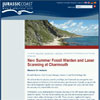

|
ConSci staff help to scan the coastline |
The Jurassic Coast may be a fascinating place to visit, but unfortunately it is fast becoming a victim of its own success. Sadly, many people who visit the area now insist on chipping away bits of it, hoping either to find fossils or wanting to remove a piece of the cliff face as a keepsake. As a result, a summertime warden has been appointed to police the area, from the end of June through to the end of September. It’s seen as an essential move in order to help monitor and preserve the ancient rocks, but also ensure that visitors don’t put themselves in danger by chiselling away at unstable parts of the cliff face.
Bournemouth University has been at the forefront of this monitoring process, having been on hand to help out with the very latest in technology. Scientists from Conservation Sciences have been involved in placing their high-tech laser scanning unit on the beach, in front of the cliffs, then scanning entire sections at a very high resolution. This process will then be repeated at the end of the summer and again next spring in order to gauge just how much the cliffs are changing. This will help to build up a comprehensive picture of cliff and beach erosion over the coming years.
Andy Ford, a lecturer in Geoinformatics at the School of Conservation Sciences, Bournemouth University said; "Using our new state-of-the-art laser we're able to automatically scan the entire cliff face at a resolution of centimetres over hundreds of square metres. What is more, once we tell the scanner where it is and what we want it to do it takes over and scans a section of the cliff, robot fashion, in comfortably under an hour. Back in the office we stitch the sections together to make a very detailed virtual model of the entire cliff. It even takes its own pictures and pastes them over the model. The results are something to behold! Because the scanner knows exactly where it is we can make more models at different times of the year and measure the differences between them. Such a study would have been unthinkable only a short time ago, but this mind-boggling technology makes it all possible."
Read more on this story by heading to the Jurassic Coast website .
.
05/07/07